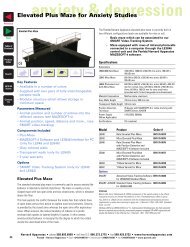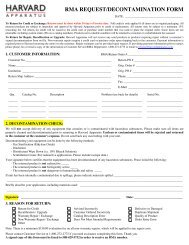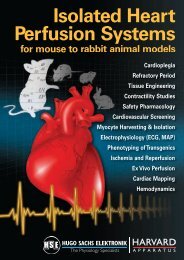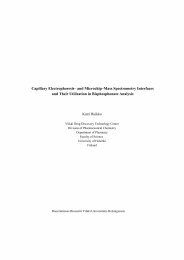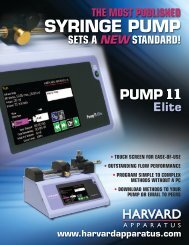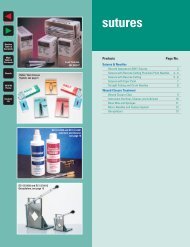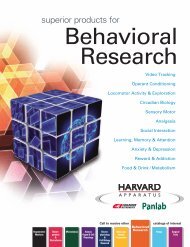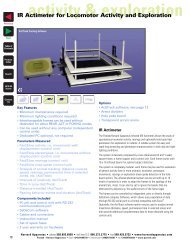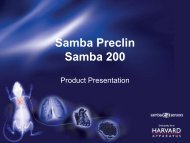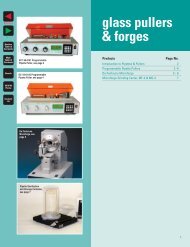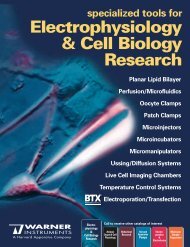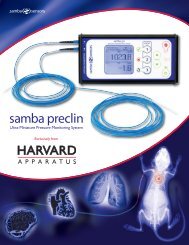sample preparation - Harvard Apparatus UK
sample preparation - Harvard Apparatus UK
sample preparation - Harvard Apparatus UK
Create successful ePaper yourself
Turn your PDF publications into a flip-book with our unique Google optimized e-Paper software.
Introduction to Equilibrium Dialysis<br />
<strong>sample</strong> <strong>preparation</strong><br />
How Does Equilibrium Dialysis Work<br />
Non-Binding Ligand<br />
Binding Ligand<br />
If the ligand and protein do not bind to each other the ligand is free<br />
to cross the membrane. At equilibrium, the concentration of the<br />
ligand in the assay chamber will be exactly half that initially placed in<br />
the <strong>sample</strong> chamber.<br />
If the ligand and protein form a complex, the bound ligand will be<br />
unable to diffuse across the membrane and will remain in the <strong>sample</strong><br />
chamber. The concentration of the ligand will still be equivalent on<br />
either side of the membrane upon reaching equilibrium. In this case,<br />
however, the ligand concentration in the assay chamber is reduced<br />
by the total amount of ligand bound to the protein divided by two.<br />
Equilibrium<br />
dialysis is a<br />
• Protein-drug binding assays<br />
specific<br />
application of<br />
• Receptor binding assays<br />
dialysis that is<br />
• Ligand binding assays<br />
important for the<br />
• Protein-protein interactions<br />
study of the<br />
• Protein-DNA interactions<br />
binding of small<br />
molecules and<br />
• Serum protein binding<br />
ions by proteins. It<br />
is one of several<br />
methods available<br />
for this purpose, and its attractive feature continues to be its<br />
physical simplicity. Another attractive feature of equilibrium<br />
dialysis is the ability to perform interaction studies without the<br />
use of fluorescent or radiolabeled tags.<br />
Generally, the objective of an equilibrium dialysis experiment is<br />
to measure the amount of a ligand bound to a macromolecule.<br />
This is typically done through an indirect process because in<br />
any mixture of the ligand and macromolecule, it is difficult to<br />
distinguish between the bound and free ligand. If, however,<br />
the free ligand can be dialyzed through a membrane, until its<br />
concentration across the membrane is at equilibrium, the free<br />
ligand concentration can be measured easily. Data obtained<br />
under different experimental conditions then provides<br />
information on various binding parameters of the compounds<br />
such as the binding constants and the number of binding sites<br />
or binding capacity.<br />
<strong>Harvard</strong> <strong>Apparatus</strong> offers five types of Equilibrium DIALYZERS .<br />
These products can meet virtually all of your bind-interaction<br />
application requirements:<br />
Fast Micro-Equilibrium DIALYZER - Reusable<br />
The reusable Micro-Equilibrium DIALYZER is available as 2-chamber<br />
system for quicker equilibration time using dialysis membranes with<br />
larger surface areas. It is used to study interactions between<br />
biomolecules such as the binding of a ligand to a protein. For <strong>sample</strong><br />
volumes from 25 µl to 500 µl, see pages 50-51.<br />
Multi-Equilibrium DIALYZER - Reusable<br />
For simultaneous and highly reproducible equilibrium dialysis of up to<br />
20 <strong>sample</strong>s with volumes from 0.2 to 5 ml, see page 52.<br />
DispoEquilibrium DIALYZER - Single Use<br />
A disposable version of the Micro-Equilibrium DIALYZER suitable for<br />
<strong>sample</strong>s from 25 to 75 µl, see page 53.<br />
96-Well DispoEquilibrium DIALYZER - Single Use<br />
A 96-well disposable equilibrium dialyzer for high throughput<br />
interaction studies. For <strong>sample</strong>s from 50 µl to 300 µl, see page 54.<br />
www.harvardapparatus.com Contact <strong>Harvard</strong> <strong>Apparatus</strong> phoneto 508.893.8999 receive a free copy • toll of our free ‘Guide U.S. to 800.272.2775 Equilibrium Dialysis’. • fax 508.429.5732 49



